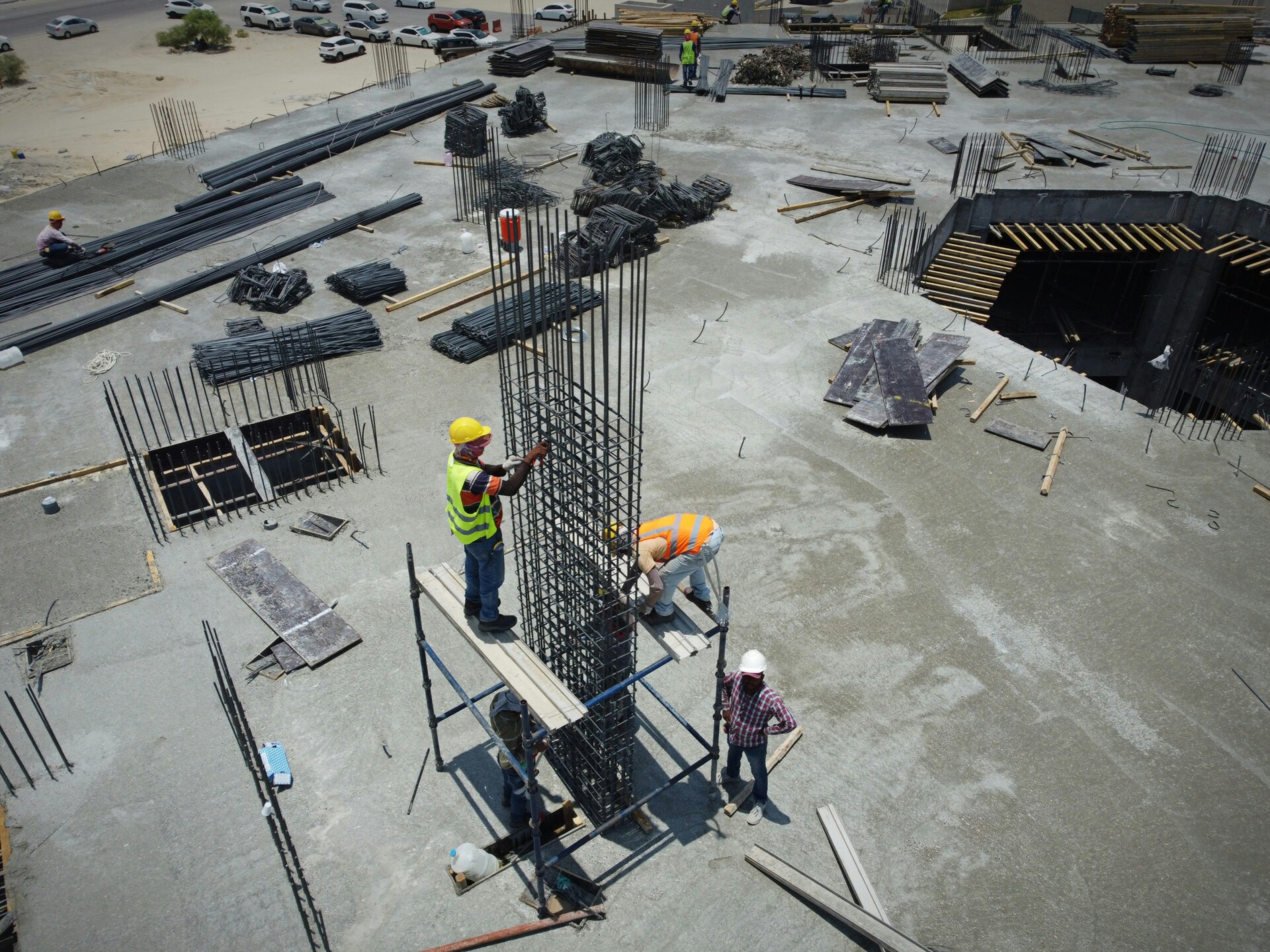Cost overruns plague 98% of megaprojects globally, often exceeding budgets by 30% or more. This stark reality underscores why construction planning has become the critical difference between project success and costly failure.
Construction planning defines how we manage and execute projects from initial design through final closeout. We establish scope of work, resource allocation, schedules, budgets, and communication protocols that guide every decision and action throughout the project lifecycle.
What Should A Construction Plan Include?

We structure every construction plan around comprehensive documentation that captures all project requirements from start to finish. At EB3 Construction, we ensure our construction plans serve as complete roadmaps that guide decision-making, resource allocation, and execution throughout the entire build process.
Project Foundation And Scope Definition
Project overview and objectives establish the foundation by defining what we aim to accomplish, the desired outcomes, and success metrics. We document the scope of work with precise inclusions and exclusions, preventing misunderstandings about deliverables and responsibilities. This clarity protects both our team and property owners from costly scope creep during construction.
Resource requirements encompass labor specifications, equipment needs, and material quantities. We detail skill levels, crew sizes, specialized equipment, and material specifications to ensure availability when needed. The construction schedule outlines key milestones, phase durations, and critical dependencies that drive project completion.
Budget And Financial Controls
The construction budget includes direct costs for labor, materials, and equipment, plus indirect expenses like permits and insurance. We allocate contingency funds, typically 5-15% of total project cost, to address unforeseen conditions. Our budget documentation aligns financial projections with schedule phases to maintain cash flow control.
Architectural drawings and visual renderings provide technical specifications and design intent. Construction specifications detail material standards, workmanship requirements, and quality expectations for each trade. These documents serve as contractual references during construction and final inspections.
Procurement And Quality Management
The procurement plan coordinates material deliveries with construction sequences to minimize site storage and handling costs. Delivery schedules account for lead times, weather delays, and site access constraints. We integrate vendor capabilities and regional availability into our planning process.
Quality assurance and quality control plans establish inspection protocols, testing requirements, and acceptance criteria. We define quality benchmarks for each construction phase and specify documentation requirements for compliance verification. Change management procedures outline approval workflows when project modifications become necessary.
Site Operations And Safety Planning
Site logistics coordinate material storage, equipment staging, and traffic flow patterns. We plan temporary facilities, utility connections, and waste collection areas to support efficient operations. Traffic management addresses both on-site circulation and surrounding area impacts during construction activities.
Construction safety plans identify hazards, specify personal protective equipment requirements, and establish emergency procedures. We conduct site-specific hazard assessments and implement safety protocols that exceed OSHA standards. Waste management strategies minimize environmental impact through reduction, reuse, recycling, and proper disposal methods.
Communication And Team Structure
Our communication plan defines stakeholder notification procedures, meeting schedules, and reporting formats. We establish clear channels for progress updates, issue resolution, and change order processing. Risk management plans identify potential project threats and specify mitigation strategies for schedule, cost, and quality protection.
Team roles and responsibilities clarify accountability throughout the construction process. We define decision-making authority, reporting relationships, and coordination requirements among all project participants. This organizational structure ensures efficient communication and prevents delays caused by unclear responsibilities.
How Do You Plan A Project Step By Step?
We approach construction planning through a structured, iterative path that builds momentum from concept to closeout. Each step provides the foundation for the next, creating a comprehensive roadmap that guides teams through complex build sequences. This methodical approach ensures we capture every detail while maintaining flexibility for adjustments as projects evolve.
Project Initiation And Feasibility Assessment
We begin by developing a project initiation document that establishes the high-level framework. This document captures key personnel assignments, resource requirements, and preliminary budget estimates that set realistic expectations from day one. The feasibility study confirms whether the project can be delivered within the proposed constraints of time, cost, and technical requirements.
The business case evaluation examines market conditions, regulatory environment, and financial viability. We assess site conditions, zoning restrictions, and utility availability during this phase. These early assessments prevent costly discoveries later in the process and provide stakeholders with confidence in project viability.
Scope Definition And Work Breakdown Structure
Stakeholder meetings capture detailed requirements that translate abstract goals into measurable deliverables. We document inclusions and exclusions explicitly to prevent scope creep and establish clear boundaries for the construction team. Requirements gathering involves architects, engineers, end users, and regulatory authorities to ensure comprehensive coverage.
The work breakdown structure visualizes how major deliverables decompose into manageable tasks. We organize work packages by discipline, trade sequence, and logical construction phases. This hierarchical structure becomes the backbone for scheduling, resource allocation, and progress tracking throughout the project lifecycle.
Material Quantification And Pricing
Material takeoff involves systematic measurement of all construction materials from architectural and engineering drawings. We calculate quantities for concrete, steel, lumber, fixtures, and specialized components using industry-standard measurement practices. Bill of quantities organizes these calculations into standardized formats that facilitate accurate pricing and procurement.
Vendor quotes provide current market pricing for materials and equipment rentals. We request quotes from multiple suppliers to ensure competitive pricing and identify potential delivery constraints. This pricing data feeds directly into budget development and cash flow projections for the construction phase.
Schedule Development And Resource Planning
Activity precedence relationships define the logical sequence of construction tasks. We identify finish-to-start, start-to-start, and finish-to-finish dependencies that govern work flow. Critical path analysis reveals which activities control overall project duration and require closest monitoring during execution.
Duration estimates consider crew sizes, productivity rates, and equipment availability for each activity. We factor in weather delays, permit approval times, and material delivery schedules. Resource needs include labor crews, equipment rentals, and subcontractor capacity across the entire project timeline. Milestones mark key completion points that stakeholders can track for progress assessment.
Budget Development And Cost Control
We assign costs systematically across labor, materials, equipment, and subcontractor categories. Labor costs include base wages, benefits, overtime premiums, and productivity factors. Equipment costs cover rentals, fuel, maintenance, and operator wages for the duration needed on site.
Subcontractor pricing comes from competitive bidding processes that ensure market rates. Contingency allocations address unforeseen conditions, design changes, and market fluctuations. The budget aligns with the schedule to create accurate cash flow projections that support financing and payment planning.
Procurement And Contracting
Contractor selection follows a systematic evaluation process that weighs experience, capacity, pricing, and safety records. We negotiate contracts that protect project interests while providing fair terms for subcontractors. Contract documents specify scope, schedule, payment terms, and performance requirements.
Vendor agreements secure material deliveries at agreed prices and delivery dates. We coordinate delivery schedules with construction sequences to minimize storage requirements and reduce theft risk. Long-lead items receive priority attention to prevent schedule delays from material shortages.
Site Preparation And Permitting
Jobsite facilities include temporary offices, material storage areas, equipment staging zones, and worker amenities. We establish site security, utility connections, and waste management systems before construction begins. Site layout considers traffic flow, crane placement, and material handling efficiency.
Permit acquisition follows local jurisdiction requirements for building, electrical, plumbing, and specialty work. We submit applications early to account for review periods and potential revisions. Inspection schedules coordinate with construction milestones to prevent work stoppages from delayed approvals.
Execution And Performance Monitoring
Plan communication ensures all teams understand their roles, schedules, and quality expectations. We conduct kickoff meetings, distribute updated drawings, and establish regular progress reporting protocols. Team alignment meetings address coordination issues and maintain focus on project objectives.
KPI tracking monitors schedule performance, cost control, quality metrics, and safety indicators. We maintain detailed records of daily progress, weather conditions, change orders, and field decisions. This documentation supports accurate progress billing, change order justification, and lessons learned capture for future projects.
Project Closeout And Continuous Improvement
Budget reconciliation compares final costs against original estimates to identify variances and their causes. We document cost overruns, savings opportunities, and pricing accuracy for similar future work. Final payments to subcontractors and suppliers close out all financial obligations.
Lessons learned documentation captures both successes and challenges encountered during construction. Team reviews examine what worked well, what could be improved, and what should be avoided in future projects. These insights feed into our continuous improvement process, making each subsequent project more efficient and profitable than the last.
Which Planning Techniques And Tools Are Most Useful?

The construction planning methods we implement depend heavily on the project’s complexity and specific constraints. We’ve found that selecting the right techniques from the start saves time, reduces costs, and ensures smoother project execution throughout the construction process.
Critical Path Method (CPM)
CPM identifies task dependencies and calculates the minimum project duration by mapping the longest sequence of activities. This proven technique excels at revealing which activities drive the project’s end date and where we have scheduling flexibility. We use CPM most effectively on complex commercial projects where understanding activity relationships is crucial for maintaining schedule control.
The method works exceptionally well when we need to allocate resources strategically and understand the ripple effects of potential delays. CPM provides the mathematical foundation for making informed decisions about acceleration strategies and resource optimization throughout the project lifecycle.
Program Evaluation And Review Technique (PERT)
PERT handles uncertainty by incorporating optimistic, likely, and pessimistic time estimates for each activity. This technique proves invaluable when we’re dealing with activities that have highly variable durations or when historical data is limited. PERT excels on projects where weather conditions, regulatory approvals, or specialized work creates scheduling uncertainty.
We deploy PERT most effectively during the early planning phases when we need to communicate realistic timelines to stakeholders while accounting for potential variables. The technique’s strength lies in its ability to quantify risk and provide probability-based completion dates rather than fixed deadlines.
Line Of Balance (LOB)
LOB tracks repetitive work across multiple locations, making it ideal for projects like highway construction, pipeline installation, or high-rise buildings where similar activities repeat across different areas. This technique helps us forecast progress rates and optimize crew movements between work locations. We apply LOB when resource continuity and production rates are critical success factors.
The method shines when we need to balance crew productivity against project milestones while maintaining steady workflow. LOB provides clear visibility into resource utilization patterns and helps us identify opportunities to improve efficiency across repetitive operations.
Resource-Oriented Scheduling
Resource-oriented scheduling prioritizes the allocation of limited labor, equipment, or specialized tools across competing activities. We implement this approach when high-value resources create project bottlenecks or when equipment availability directly impacts the critical path. This method works best on projects where resource constraints are more limiting than activity durations.
We find resource-oriented scheduling particularly effective for managing crane time, specialized equipment rentals, or skilled trade availability. The approach helps us balance workload distribution and minimize resource conflicts before they impact project timelines.
Gantt Charts And Network Diagrams
Gantt charts visualize project timelines, dependencies, and milestones in a format that’s easily understood by all project stakeholders. We use Gantt charts for communication and control rather than detailed scheduling analysis. Network diagrams complement Gantt charts by showing logical relationships between activities without the time-scale constraints.
These visualization tools prove most valuable during stakeholder meetings, progress reporting, and project communications. We rely on them to present complex scheduling information in formats that owners, architects, and subcontractors can quickly understand and act upon.
Construction Planning Software Integration
Modern construction planning software centralizes schedules, project files, progress tracking, resource management, time tracking, dashboards, and reporting capabilities. We integrate these platforms to support real-time decision making and maintain current project information across all stakeholders. The software becomes our central coordination hub for all planning and execution activities.
We select software solutions based on their ability to integrate with existing workflows, provide mobile field access, and generate meaningful reporting for project control. The most effective platforms support multiple scheduling techniques while maintaining data consistency across all project participants.
How Do You Manage Risk, Safety, And Quality During Construction Planning?
Managing risk, safety, and quality during construction planning requires systematic approaches that identify potential issues early and establish control mechanisms before work begins. We integrate these three critical elements into our planning process to protect project outcomes and ensure successful delivery.
Risk Management Strategy
We identify financial, project, legal, and safety risks during the initial planning phases. Financial risks include cost overruns from material price fluctuations, slow payments from clients, and unexpected expense escalation that can strain cash flow and jeopardize project completion.
Project risks encompass schedule delays from weather conditions, equipment failures, or workforce interruptions that could derail construction objectives. Legal risks involve regulatory compliance violations, contract disputes, and potential litigation from scope disagreements or quality deficiencies.
Our risk mitigation strategies include developing contingency plans for identified threats, establishing financial reserves for unexpected costs, and creating clear contractual agreements that define responsibilities and liability. We monitor risks throughout project execution through regular assessments that track changing conditions and emerging threats that require immediate attention.
Safety Planning Protocols
Safety planning begins with comprehensive hazard assessments that identify potential dangers specific to each project site and work activity. We conduct pre-work safety meetings that review equipment operation procedures, establish safe work practices, and ensure all personnel understand protective measures required for their tasks.
Personal protective equipment enforcement includes mandatory hard hats, safety glasses, high-visibility clothing, and task-specific gear like fall protection harnesses or respiratory equipment. We control site access through designated entry points, visitor registration systems, and restricted zones that limit exposure to construction hazards.
Clear signage placement throughout the work area warns of specific dangers like overhead hazards, electrical risks, or excavation areas that require extra caution. Routine safety inspections occur daily to verify compliance with established protocols, identify emerging hazards, and document corrective actions taken to maintain safe working conditions.
Quality Assurance And Control Framework
We establish quality benchmarks that align with project specifications, regulatory codes, and client expectations through detailed quality management plans. These benchmarks define acceptable standards for materials, workmanship, and finished construction that guide all quality verification activities.
Inspection and testing protocols specify when, how, and who conducts quality checks at critical construction phases. Material inspections verify that delivered products meet specification requirements before installation, while workmanship assessments evaluate installation quality through visual inspection, dimensional verification, and functional testing.
Balancing cost, scope, and time constraints while maintaining quality visibility requires careful coordination of the triple constraint elements. We use change management procedures that evaluate proposed modifications for their impact on schedule, budget, and quality outcomes before approving alterations to the original plan. This systematic evaluation prevents scope creep and ensures that changes support rather than compromise project objectives.
Quality control documentation creates traceable records of all verification activities, non-conformance reports, and corrective actions that demonstrate compliance with established standards and provide evidence for project closeout and warranty purposes.
Conclusion And Next Steps

Construction planning serves as the master roadmap that connects every critical element of a successful project. We approach each project by starting with thorough initiation and stakeholder alignment, establishing a clear work breakdown structure to organize deliverables, quantifying materials and pricing accurately, then developing realistic schedules that account for resource constraints and project dependencies. Throughout execution, we set meaningful KPIs to track performance across schedule, cost, and quality metrics while maintaining detailed project records that support informed decision making.
The construction planning process demands flexibility and continuous refinement. We treat our plans as dynamic documents that evolve with changing site conditions, design modifications, and unforeseen challenges. By implementing robust change management protocols and maintaining open communication channels with all project stakeholders, we ensure that adjustments enhance rather than derail project objectives. Each project closure becomes an opportunity for organizational learning, where we systematically document lessons learned, analyze what worked well, and identify areas for improvement that will strengthen future planning efforts.
Ready to implement strategic construction planning on your next project? Contact EB3 Construction to discuss how our systematic approach can deliver your project on time and within budget.




